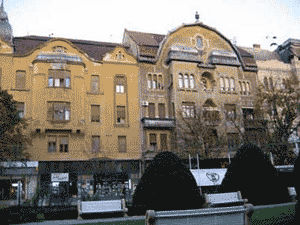
|
Hello,
|
SPL. TUDOR VLADIMIRESCU 14, 1900 TIMIŞOARA, ROMÂNIA
|
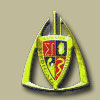

The 20th International Congress of the European Federation for Medical Informatics; August 27 – 30, 2006, Maastricht, Holland – "Technologies For Better Health in Aging Societies"
August 20 – 24, 2007, Brisbane Australia
11-16 June 2006, Seoul, Korea
|

about timiŞoara
more history: Timişoara, the capital of Banat
From "Timişoara - short history"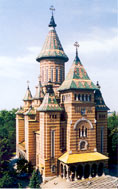 Timişoara (Tee-mee-shoa-ra) dates back in the time earlier than the first written echoes or documents about it. The diverse palette of neolithic archaeological material, dug out within the precincts of the town, attest the existence of a longstanding settlement with a population of tillers and handicraftsmen.
Timişoara (Tee-mee-shoa-ra) dates back in the time earlier than the first written echoes or documents about it. The diverse palette of neolithic archaeological material, dug out within the precincts of the town, attest the existence of a longstanding settlement with a population of tillers and handicraftsmen.
The Banat played an important part in the wars between the Dacians and the Romans, as well as during the Roman rule in the north of the Danube River. Many localities still bear the mark of those tumultuous times. In the south-west of the town one can still see fragments of solid entrenchments currently known under the name of the Roman-Moat. The historian Francesco Grisellini holds that the walls of the medieval fortress were built on the foundation of a former Roman castrum.
At a time of great unrest and anxiety brought about by the migratory populations repeated raids, the inhabitants of thosevillages kept up their traditions and ocupations. Their specific form of organisations was thw territorial village communities ("popular Romanitiees"). For reason of defence, strong fortifications were made in order to control the roads and crossings, and thus secure survival in those turbid days. Such fortifications were built in Timişoara, in an area encircled, today, by Pietroasa Street, Alba-Iulia Street, Iancu de Hunedoara Square, Bocsa Street. It may have been one and the same with "Castrensis of Tymes" or "Castrum regium Themes" recorded by the early medieval sources: an indirect source in 1177, and a direct one in 1266.
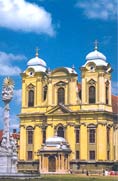
Besides the military and administrative role played by Timişoara, it has always had a major religious and political part since it came into being. The citadel was the religious centre of Romanians of the Banat, during the Xth-XIIIth centuries, until 1232.
Timişoara s history is closely connected and directly engaged inthe effort made for stemming the Ottoman advance towards the centre of Europe. It was often the gathering place for the Christian armies. At the beginning of the XVth century, ample Turkish forays threatened the town causing great casualties in the carnage of battle. Backed by the peasants battalion commanded by Romanian knezes, Timişoara s garrison resisted heroically and it was not only once that they did carry the resounding day.
In his plans for the defence of Christian Europe's liberty Iancu de Hunedoara (John Huniadyi) kept Timişoara for a very special part. The citadel became the centre of a permanent military base. He gathered his army on the plain near the walls of the town and then left for "the long campaign" in the fall of of 1443, and then for Varna. This town was also the place from where initiatives were started in order to grantassistance for Walachia and Moldavia. It was here that Iancu de Hunedoara brought his royal family after having consolidatedand fortified the castle (fortress). During the second half of the Xvth century Timişoara was the stage of violent struggle among the nobiliary parties, as well as of devastating repeated attacks waged by the Ottoman armies.
In the early Xvth century, Timişoara knew dramatic social confrontations. The feudal rule, more and more oppresive, determined the bulk of peasantry to rise in arms under the leadership of Gheorghe Doja. In the summer of 1514, the peasants army reached the town, trying to take possession of it and turn it into a centre of resistance.
The long stretch of time under the Turkish domination (164 years) was also marked by political unrest and military confrontations. Timişoara also played an outstanding part in the anti-Otoman Uprising of the 1594 spring, in which Romanians and Serbians united against their common foe. The uprising was also closely connected to the fight for independence initiated by Mihai Viteazul (Michael the Brave). In the summer of 1596, the Romanian Voivode sent 4000 of his soldiers to participate in the siege of Timişoara. In 1600 he resume his plan; two reports show that the intention of Michael (the maker of the first union of the Romanian "lands") was "to snatch the citadel of Timişoara away" from the Turks hands. The Prince's assasination put an end to this project.
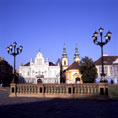
The XVIIth century brought in even more turmoil, Timişoara was again in the foreground of the wars between the Ottoman and the Habsburg Empires; it was equally torn among the nobiliary parties. The Imperial Habsburg army surrounded the town in 1689 and kept it under siege for two years, withou succeeding to defeat the Turkish garrison. In 1696 the Habsburg troops resumed their attacks; a fearful fight followed near the fortifications but the town could not be taken. In the summer of 1716 a stronger Habsburg army led by Eugene de Savoya reached the gates of citadel. Minute engineering works were developed and repeated bombardments prepared the decisive assault of October 1, 1716. After twelve days of battles, the Ottoman garrison capitulated and left Timişoara never to return. On October 18, Eugene de Savoya entered the citadel triumphantly, imposing the new Habsburgic rule which was to last for two hundred years.
In the second half of the XIXth century Timişoara was to become an active presence in the national and social movement. On the 18th and 19th of November 1860 it was the host of the National Conference of the Romanians of Banat, claiming the Banat s autonomy and its tearing off from Hungary, demanding guarantees for the Romanians. It was in Timişoara that they laid the foundations of the National Party of Romanians of the Banat and Hungary, in 1860, led by Alexandru Mocioni. Romania s efforts in the 1877 War of Independence were supported by the town s population with offerings; they also took part in political activities for national and social rights, for the adoption of the universal suffrage. From this ample national movement, in which Timişoara had its major contribution, the 1918 Union of the Principalities would, eventually, become a reality. At Alba Iulia, on 1 December, many Romanians from Transilvania were present at the Grand National Assembly, where they upheld the unconditioned union of the Banat and Transylvania with Romania.
The union of all the romanian provinces created favourable possibilities for a more rapid developement of Timişoara. In the period between the two World Wars a substantial progress was felt in its economic, social and cultural life. Timişoara become one of the most important urban centres of Romania, a model of civilisation and of coinhabiting.
